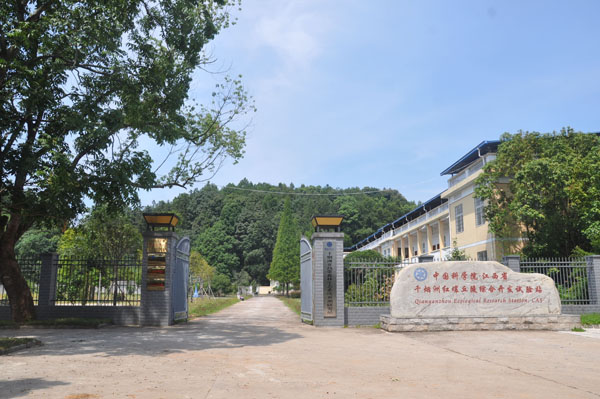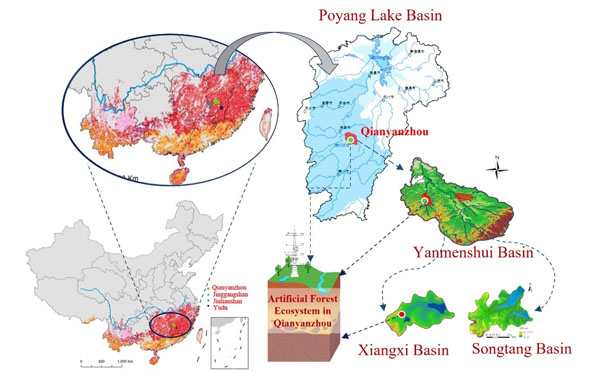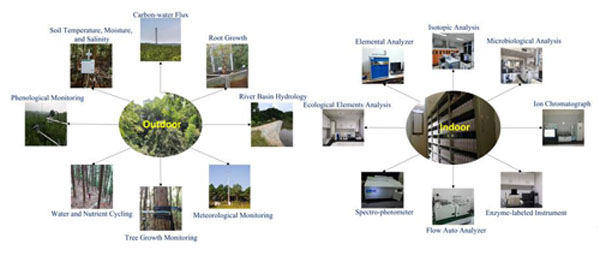Qianyanzhou Ecological Research Station
History
Qianyanzhou Ecological Research Station (Qianyanzhou Station), Chinese Academy of Sciences was founded by Chinese Academy of Sciences (CAS) in 1983. Qianyanzhou Station developed a famous model known as "Qianyanzhou mode" in the 1980s, providing a good demonstration for restoring degraded hilly lands and improving ecosystem services in subtropical China. In 1992, it was nominated by Man and Biosphere Programme (MAB) as an international experimental station and became a training center of the United Nations Development Programme (UNDP) Jiangxi Project. In 2002, Qianyanzhou Station became a member of ChinaFLUX. In 2021, the station was approved as National Critical Zone Observatory of Red Soil Hilly Region in Qianyanzhou, Jiangxi Province.

Qianyanzhou Ecological Research Station, CAS

Regional representation of Qianyanzhou Station
Natural Conditions
Qianyanzhou Station is located in Taihe County, Jiangxi Province in Southern China (26°44'48"N, 115°04'13"E). This area is characteristic of a typical subtropical monsoon climate with average annual air temperature of 17.8 °C and mean annual precipitation of 1485 mm. The average elevation is approximately 100 m with a relative relief of 20-50 m. Red soil, dominating the subtropics of south China, is the primary soil type in the station. Due to deforestation and unreasonable land utilization, the original vegetation, such as evergreen broad-leaved forest, had been replaced by planted forests, shrubs and some secondary vegetation. The forest canopy, mainly composed of Pinus elliottii, Pinus massoniana and Cunninghamia lanceolata, has increased from 0.4% to 70% since the establishment of the station.

Landscape of Qianyanzhou Station
Long-term Objective
One of the objectives of the station is to study the structure and processes of subtropical forest ecosystems. Under the framework ofEarth’s Critical Zone science, the main task of the station is to better understand the interactions among rock, soil, water, air, and plants in the red soil hilly region.
The Major Tasks
1. The biogeochemical processes of plant-air and root-soil interface in the red soil hilly critical zone
2. Observation and modelling of the cycles of carbon, nitrogen and water, and their responses to global changes in subtropical forest ecosystems
3. Multi-scale biogeochemical patterns and processes from watershed to regions in the red soil hilly critical zone
4. Sustainable management of ecosystems and ecological restoration mode in red soil hilly region

Landscape changes at Qianyanzhou Station from 1983 to 2019
Facilities
Qianyanzhou station has established observation network, including a subtropical forest in Qianyanzhou, a degraded forest in Xingguo County, a natural secondary forest in Jinggangshan National Reserve and an evergreen broad-leaved forest in Jiulianshan National Reserve.

Field scientific observation and research platform of Qianyanzhou Station

Flux tower
Collaborators
At Qianyanzhou Station, collaborators include scientists from more than 20 organizations across the different institutes of CAS, Peking University, China Academy of Forestry, Jiangxi Agricultural University, Huazhong Agricultural University, German Federal Agency for Nature Conservation, Pennsylvania State University, University of California, Los Angeles, and National Institute of Environmental Studies in Japan.
Research Opportunities
Qianyanzhou Station staff welcomes new studies and collaboration on existing ones. There is a need for expanded cooperative research in the CZ science and Ecology field.
Contact
Dr. Zeqing Ma
A11, Datun Road, Chaoyang District, Beijing 100101
Tel: +86-10-6488 9027
Email: mazq@igsnrr.ac.cn